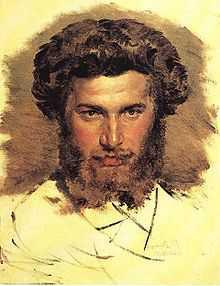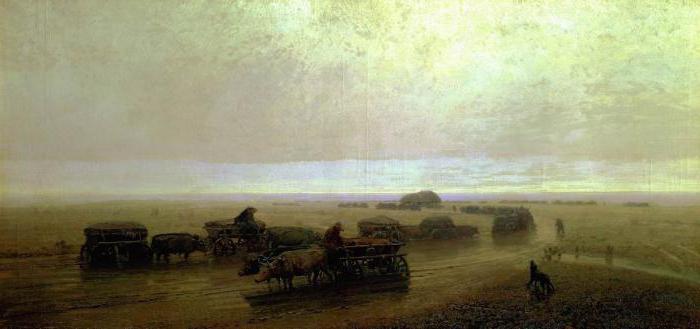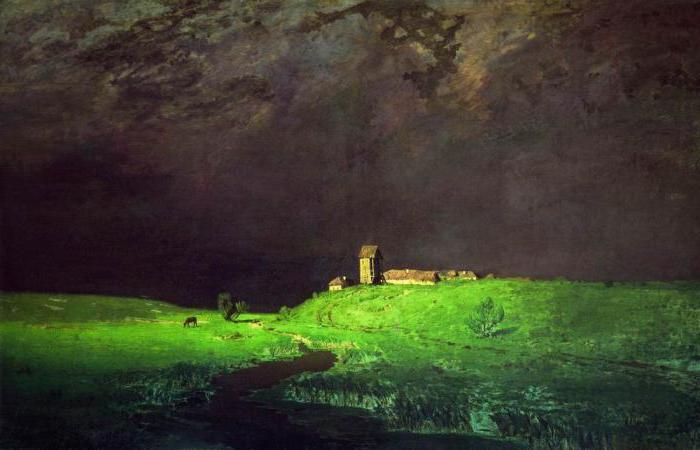The stubbornness of the impoverished Greek boy, who, contrary to all circumstances, became the pride of Russian painting, is striking. A brief biography of Kuindzhi speaks of the extraordinary giftedness, determination and generous soul of the great painter.
Childhood and youth
Such a detail is already surprising that the exact date of birth of Kuindzhi has not been established. The biography begins with hesitation - whether the year 1841, or 1842. This is not fundamental, but strange. In the same unusual way, the translation of his last name, which meant the master of gold, will be reflected in all his activities as a painter. Arkhip was orphaned early. He was raised by poor relatives. Learning without diligence, he continuously painted on all pieces of paper that only came to hand.

Poverty and poverty forced him to graze geese, work as a brick accountant, and then with a bread merchant. But there was a thirst for painting, which brought him to Theodosius. The 14-year-old Kuindzhi, whose biography was just beginning, dreamed of becoming a student of the great I.K. Aivazovsky. But it didn’t work out - he was entrusted with only rubbing paint and painting the fence. He returned to his native Mariupol and became a retoucher - not a painting, but something similar. Until the age of 24, he rushed along the Black Sea coast, working the same way.
Petersburg
At the Academy of Arts, no one was waiting with open arms of Kuindzhi. Biography in St. Petersburg began with unsuccessful attempts to learn high art. He was simply not accepted into the Academy. But three years later he painted a picture that he exhibited at the Academy's exhibition. Then he was finally noticed, awarded the title of free artist and even admitted to passing exams in the specialty. The diploma Kuindzhi biography enriched by acquaintance with the Wanderers. In 1875, he exhibited his work "Chumatsky Highway in Mariupol."

It does not yet have that Kuindzhi, whom we all represent in more mature independent work. This is a realistic canvas characteristic of the Wanderers: gloomy coloring, impassable dirt. Everything is inspired by the theme of the hopeless life of the people, which the Wanderers loved so much. But he was noticed, and, having believed in himself and making a departure from the "Partnership", Kuindzhi, whose biography is still unstable, leaves for studies to the north.
Development
He creates landscapes "On the island of Valaam", "Lake Ladoga", which attract public attention. Arkhip Kuindzhi, whose biography is on take-off, can afford to marry a girl he has long loved. And a year later, he puts out a picture that struck not only the public, but even sophisticated fellow artists - “Ukrainian Night”.

This is a visible turning point in creativity, an exotic innovation inherent only to him alone. Now Kuindzhi will begin to think over everything - both topics and the manner of writing, independently developing his achievements, deeply studying paints, colors and lighting effects, enjoying their beautiful game. In 1878, at an exhibition in Paris, where Kuindzhi arrived with his young wife, he amazed the French public with an exhibition of his works. He was recognized as the most Russian and most original painter. In the same year, he began work on which he would work for 23 years, “Evening in Ukraine.” In France, he studies impressionism and, under his influence, will later write three landscapes - “North”, “Birch Grove” and “After the Rain”.

Long overdue, like an abscess, the exit from the Partnership of the Wanderers took place, and after that Kuindzhi puts up one picture - “Moonlit Night on the Dnieper”. It was an explosion. No wonder the artist experimented so much with paints and lighting, which he made special at the exhibition, darkening the hall and highlighting his canvas. But ignorance of chemistry played a nasty joke with the work - over time, the colors darkened, and now it does not make an initial impression, although it is still beautiful.
This is a new stage in creativity, the artist-philosopher - Arkhip Ivanovich Kuindzhi was born. The biography speaks of his thoughts about reality, about other ways of expressing it on the canvas. He seeks to comprehend the depths of the material world. Remember that it was once just a little trained, who did not graduate from the Academy of Arts, an almost impoverished orphan. To what heights of spirit with talent and hard work can a man rise!
Privacy
In the years 1881-1882, Kuindzhi organized two more exhibitions, which showed "Birch Grove", thundered loudly among lovers of painting, and "Dnieper in the morning." This work was taken very restrained. After this, the painter retreats from public life for almost twenty years. Biography cannot explain the retreat of such a famous person as the artist Kuindzhi. At the zenith of fame, he disappears from the field of view of the public and criticism.
Work alone
Kuindzhi works by creating new paints that must be stable and not change their appearance over time and under the influence of air. He writes more and more new works, looking for another style direction. In 1886, he buys a plot of land in the Crimea, where, living with his wife and students, he works in the warm season, following the example of the impressionists in the open air and writes, “View of the sea and the coast. Crimea ”,“ Sea coast. View of Mount Demerdzhi. Crimea "," Crimea. Yayla "," Hillside. Crimea ”and much more. This is a completely different Kuindzhi, filled with light, sun and the salty breeze of a calm sea.
Caucasus
In 1888, at the invitation of one of the Wanderers, Kuindzhi traveled to the Caucasus and brought fresh impressions and studies from there, which he continued to work on in St. Petersburg. He reflected the majestic Caucasus by writing a series of paintings: "Elbrus in the afternoon," "Elbrus. Moonlit night ”,“ Snow peaks ”,“ Snow peaks. Caucasus".
This is a short list of his works, in which he philosophically comprehends the grandeur of the world around him. This is completely different, updated both technically and internally by Kuindzhi, when the romantic merges with the philosopher. Critics believe that it was the Caucasian period of Kuindzhi that influenced the work of N.K. Roerich in the Himalayas. After all, the Kuindzhi Caucasus is symbolic. This is the highest unattainable ideal, dazzlingly beautiful at the same time.
New exhibition
In 1901, the artist leaves solitude and shows friends and students the work begun twenty-three years ago, “Evening in Ukraine”, as well as the works “Christ in the Garden of Gethsemane” (1901), “Birch Grove” (1901). In general, by this time the painter had created about five hundred works. In those same years he performed the views of Moscow from the Sparrow Hills. Taking a topic, he completely develops it, and then, turning to another, he also creates a series of paintings connected among themselves, without repeating and surprising when you watch his works in sequence. Amazingly diverse are not only the topics, but also their coloristic decisions.
The exhibitions made by Kuindzhi again led the audience to an enthusiastic state, disputes and conversations started again about him, but the artist again closed. A brief biography, like his contemporaries, cannot provide the reasons for this behavior of Kuindzhi. Maybe the artist was tired of empty talk, because he was sixty years old. True, by our standards this is not so much, but then they thought a little differently.
Last years
Ten years Kuindzhi created all new paintings. An absolute masterpiece of that time is the painting “Rainbow”. She is in the Russian Museum. Kuindzhi worked on this work for five years. Along a huge field, which has not yet streaked, a road curls fancifully. Spread over them, occupying two-thirds of the canvas, is a sky with a sparkling rainbow. Everything is extremely simple, but such simplicity is given by great skill, observation and thought. Already written "Red Sunset" and "Night" (1905-1908).
Artist's death
While in the summer of 1910 in the Crimea, he fell ill with pneumonia. This is now a formidable disease that permanently incapacitates a person. And then there were no antibiotics. With the permission of the doctors, a loving, caring spouse transported the patient to St. Petersburg, but the doctors’ efforts did not help. The sick heart could not stand it, and he died in July 1910. Now his grave is in the Tikhvin cemetery, in the Alexander Nevsky Lavra.
Charity
Having left the most unsecured lower classes of society, the artist, as soon as they began to allow funds, began to engage in charity work, giving huge money for those times (one hundred, one hundred and fifty thousand rubles) to both the Academy of Arts and the Society of Artists named after A.I. Kuindzhi for annual awards. He donated his estate in Crimea to the same society. The artist himself and his wife were content with the small, lived simply and modestly. After his death, she received the pension appointed by Arkhip Ivanovich, and the artist distributed his entire fortune between relatives and the Society of Artists.
Such a difficult life path has passed Arkhip Kuindzhi. A brief biography speaks of the extraordinary giftedness, determination and generous soul of the great painter.